From Lab to Market: The Future of Mitochondrial Function in Neurodegeneration Therapy
Neurodegenerative disorders like Alzheimer’s Disease (AD), Huntington’s Disease (HD), Parkinson’s Disease (PD), and Amyotrophic Lateral Sclerosis (ALS) are intricately linked to mitochondrial dysfunction. This dysfunction encompasses a decrease in energy production, specifically adenosine triphosphate (ATP) synthesis, alongside an increase in oxidative stress and metabolic imbalances. Given that mitochondria produce 95% of the brain’s energy and considering the global prevalence of neurodegenerative diseases affecting 55 million people, the relevance of mitochondrial health becomes even more apparent.
The critical role of mitochondria extends beyond energy production to include key processes such as brain development, synapse formation, cellular differentiation, receptor anchorage, neurotransmitter vesicle transport, exocytosis, synaptic pruning, and neuronal plasticity. These functions are essential for maintaining brain health and highlight why targeting mitochondrial dysfunction could be pivotal in treating neurodegenerative diseases (Figure 1). Understanding and addressing mitochondrial health offers a promising avenue for therapeutic innovation, potentially transforming the lives of millions affected by these conditions.
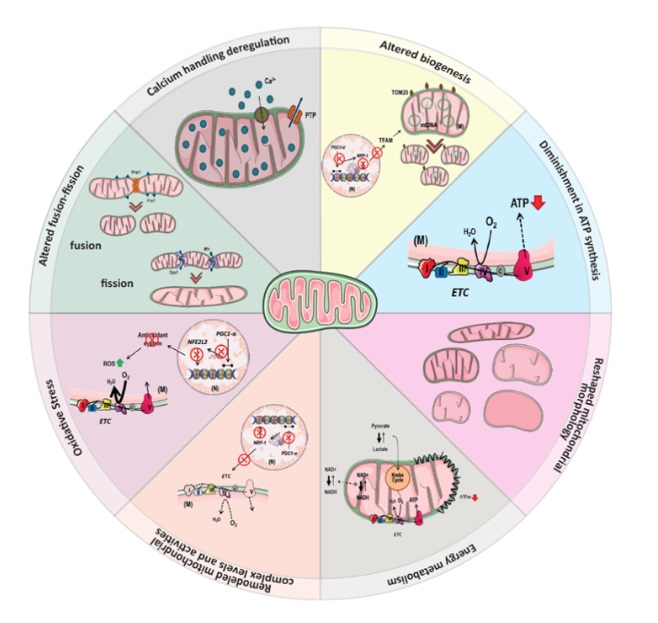
Figure 1: Schematic representation of the pivotal role of mitochondrial dysfunction in neurodegeneration. Mitochondrial dysfunction described in neurodegenerative diseases may be related to several factors, including increased oxidative stress, reduced mitochondrial complex levels and activity, dysregulation of Ca2+ homeostasis, decreased ATP levels, and changes in mitochondrial dynamics (fission and fusion processes), morphology, mtDNA copy number, and mass—figure created in BioRender.
Mitochondrial Therapy Market Potential
The neurodegenerative disorder therapeutics market, valued at USD 14.66 billion in 2021, is on a robust growth trajectory, fueled by increasing investments in research and a deepening understanding of mitochondrial dysfunction’s role in such diseases. Prominent companies, including industry giants and innovative biotechs highlighted by the MitochondriaWorld™ platform, are pioneering therapies to enhance mitochondrial function. These efforts are crucial in addressing the wide range of neurodegenerative disorders, which, despite their varied etiologies, often share common pathological mechanisms linked to mitochondrial dysfunction.
The demand for neurodegenerative disease treatments is expected to surge, driven by an ageing global population and a rising prevalence of diseases such as Alzheimer’s and Parkinson’s. Projected to include 2.1 billion individuals over the age of 60 by 2050—the demand for neurodegenerative disease treatments is set to skyrocket. The Alzheimer’s Association forecasts that the number of Americans with Alzheimer’s disease will rise from 5.8 million to 14 million by 2050. Reflecting this demand, the global neurodegenerative disorder therapeutics market is expected to reach USD 38.2 billion by 2029, growing at a compound annual growth rate (CAGR) of 29.6% from 2023 to 2029, according to GlobalData (Figure 2). This growth is further segmented by indications such as Multiple Sclerosis, Alzheimer’s Disease, Parkinson’s Disease, and Huntington’s Disease, among others, covering various drug classes and routes of administration.
Technavio predicts an acceleration of the market’s CAGR to ~8% by 2026, with potential peaks of over 12% in the US market by 2030 as per Grand View Research. North America is expected to contribute ~37%, evidencing an incremental growth of 19.7 billion dollars. By 2022, the global market size for neurodegenerative diseases will reach 41.2 billion dollars, with significant investments directed towards Huntington’s Disease, Alzheimer’s Disease, and Parkinson’s Disease.
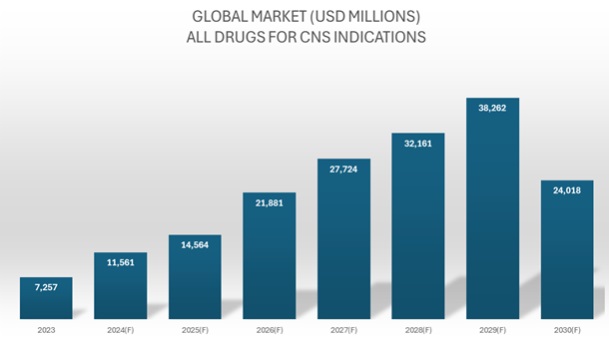
Figure 2: Market size (USD million) of drugs targeting central nervous system (CNS) indications. Source: GlobalData /April 2024.
Market Dynamics and Insights
With ongoing investments in research and development and exploring new treatment avenues, the market offers promising opportunities for addressing the unmet needs in neurodegenerative disease therapy. Stakeholders are encouraged to leverage these insights for strategic planning and investment decisions in this rapidly evolving field.
Drivers
Key factors propelling market growth include the rising prevalence of neurodegenerative diseases, increased funding for research, and a growing understanding of the diseases’ genetic and molecular underpinnings. Additionally, the ageing population globally is contributing to an increased incidence of neurodegenerative disorders, underscoring the need for effective treatments. The market for mitochondrial-based therapeutics is brimming with growth opportunities, offering a promising future for healthcare providers and patients. As research continues to uncover the intricate role of mitochondria in various diseases, the potential for developing targeted therapies expands exponentially. Reflecting this demand, the global mitochondrial targeted drugs for CNS indications are expected to reach USD 2.5 billion by 2029, growing at a compound annual growth rate (CAGR) of 97% from 2023 to 2029, according to GlobalData (Figure 3).
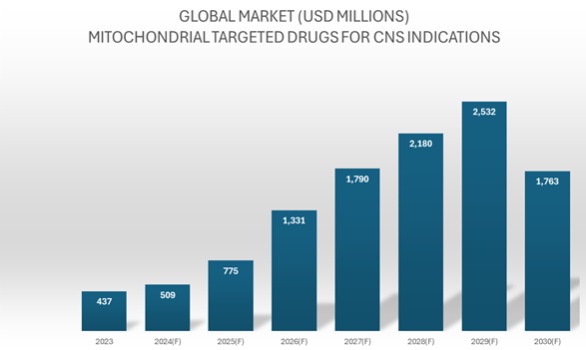
Figure 3: Mitochondrial-based therapeutic market size (in USD million) specifically for central nervous system (CNS) indications. Source: GlobalData /April 2024.
Challenges
The market faces challenges, like the high failure rate of neurodegenerative drugs in clinical trials and the need for more skilled professionals in developing countries may impede market growth. Despite these hurdles, the market is ripe with opportunities.
Opportunities and Recent Developments
Emerging opportunities in the neurodegenerative disorder therapeutics market are centred around the development of innovative treatment modalities, such as gene and cell therapies. Recent developments, such as Biogen Inc.’s acquisition of a novel clinical-stage asset from Pfizer for $75 million in January 2020, underscore the active pursuit of innovative therapies within the industry. The potential for expanding these advanced therapies into emerging nations represents a significant growth avenue for the market.
Regional Analysis
North America leads the market, attributed to heightened awareness and advanced healthcare infrastructure. Significant research and development activities and a strong presence of key market players support the region’s dominance. Asia-Pacific is expected to witness the highest growth rate from 2022 to 2029.
Scope and Segmentation
The market is segmented based on indication, drug class, route of administration, and end-user, with detailed analyses provided for each segment. This segmentation offers insights into the diverse therapeutic approaches and their target demographics, facilitating strategic market decisions and identifying core applications for industry stakeholders.
Investment Trends in Mitochondrial Research
R&D Investments. The pursuit of effective treatments for neurodegenerative diseases is intensifying, driven by the growing senior population and the critical challenge of high clinical trial failure rates. Despite these hurdles, pharmaceutical giants and biotech startups are steadfast in their R&D investments to develop therapies targeting neurodegenerative disorders, with a keen focus on mitochondrial dysfunction.
Indeed, in recent years, the field of mitochondrial-based therapeutics has witnessed several key trends that are shaping its growth trajectory. One such trend is the increasing focus on precision medicine, where therapies are tailored to individual patients based on their unique mitochondrial profiles.
Additionally, advancements in gene editing technologies have paved the way for targeted interventions, allowing for more precise and effective treatments. Furthermore, collaborations between pharmaceutical companies and research institutions have accelerated the development of novel therapeutics, bringing us closer to unlocking the full potential of mitochondrial-based treatments (Figure 4).
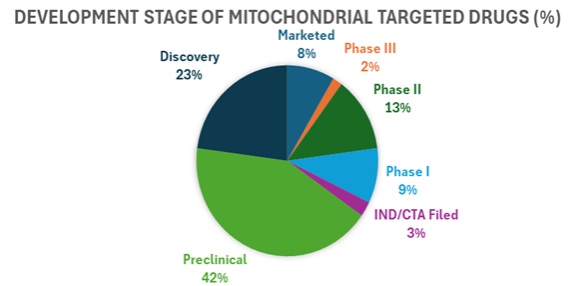
Figure 4: Graphic showing different stages of Drugs targeting mitochondrial function in the Neuroscience field. Source: GlobalData /April 2024.
Although the path to regulatory approval is steep, with few therapies currently authorized, the commitment to R&D remains strong. This dedication is particularly evident in North America, a leader in the neurodegenerative disease market, fuelled by rising medicine demand, high healthcare costs, increasing R&D expenditures, and favourable health reimbursement policies.
Venture Capital Trends
Venture capital funding in the biotech sector, especially for companies targeting mitochondrial dysfunction, reflects an optimistic outlook on the potential of mitochondrial therapies. The Asia Pacific region, notably China and Japan, is poised for significant growth in the neurodegenerative disease market, driven by an ageing population, a high frequency of neurological illnesses, and an escalating demand for medications. This growth is attracting investments in innovative therapeutic approaches that aim to enhance mitochondrial function, thereby opening new avenues for venture capital funding and partnerships.
Therapeutic Development and Commercial Opportunities
The therapeutic pipeline for mitochondrial dysfunction treatments is robust, featuring drug candidates across various stages of clinical trials. These candidates represent a diverse range of pharmacological strategies aimed at restoring mitochondrial health, such as optimizing metabolic efficiency, mitigating oxidative stress, and stimulating mitochondrial repair mechanisms.
Strategic Partnerships
Significant partnerships between companies are crucial for accelerating the development and commercialization of mitochondrial therapies. Collaborations between industry leaders like Novartis, Pfizer, Merck Serono, Biogen Idec, TEVA, and UCB, alongside emerging biotech firms, underscore the collaborative effort to tackle the complex challenge of neurodegenerative diseases through mitochondrial enhancement.
Innovative Therapies
Breakthrough therapies and novel approaches are at the forefront of efforts to combat mitochondrial dysfunction. These include strategies to enhance metabolic status, improve the efficiency of the electron transport chain, and promote mitochondrial biogenesis and mitophagy. Such innovations offer a roadmap for future research and development efforts, underlining the potential of mitochondrial-targeted therapies to revolutionize the treatment of neurodegenerative diseases.
Innovative Therapies
The neurodegeneration treatment space is witnessing a significant pivot towards mitochondrial health, driven by both established pharmaceutical giants and agile biotech startups. These entities are at the vanguard, deploying cutting-edge strategies to ameliorate mitochondrial dysfunction, a core contributor to neurodegenerative processes. This concerted effort aims to enhance mitochondrial function through a spectrum of interventions (Figure 5):
Optimizing Metabolic Status: By fine-tuning the metabolic activities within cells, researchers aim to stabilize energy production, ensuring neurons have the necessary resources to function optimally.
Improving Electron Transport Chain Efficiency: Enhancements in the electron transport chain can significantly boost ATP synthesis, directly impacting cellular energy availability and health.
Promoting Mitochondrial Biogenesis: The generation of new mitochondria within cells is crucial for maintaining cellular vitality and supporting the demands of high-energy tissues, such as the brain.
Mitophagy as a Therapeutic Target: Recognizing the importance of removing dysfunctional mitochondria, strategies to enhance mitophagy have gained prominence. This involves modulating key regulatory proteins to ensure cellular homeostasis is maintained, thereby protecting neurons from degenerative stress.
To support these innovative therapeutic strategies, the development of high-quality and robust assays is essential. These assays allow for the precise interrogation of mitochondrial function, providing insights into:
- The efficiency of the mitochondrial respiratory chain
- The overall metabolic state of cells
- The potential efficacy of new therapeutic compounds targeting cellular metabolism
By monitoring specific metabolites, researchers can glean valuable information about the state of mitochondrial health and its impact on neurodegenerative disease mechanisms. This approach is critical not only for understanding the pathophysiology of these conditions but also for guiding the development of targeted treatments that address mitochondrial dysfunction.
The Future of Mitochondrial Therapeutics
As we continue to explore and understand the intricate role mitochondria play in cell health and neurodegeneration, the therapeutic landscape is evolving. The ongoing efforts to develop innovative therapies that target mitochondrial function offer a promising roadmap for future research and development. These advancements herald a new era in the treatment of neurodegenerative diseases, with the potential to significantly improve patient outcomes by addressing the underlying causes of disease progression.
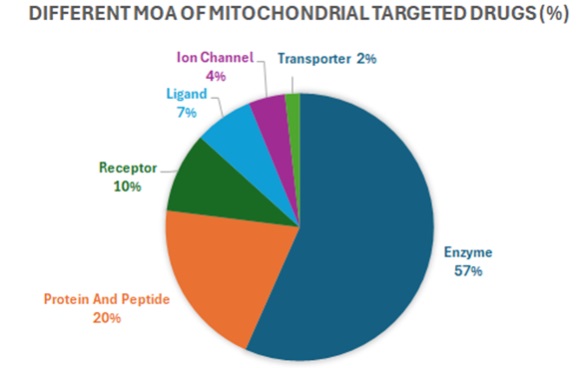
Figure 5: Graphic showing different Mechanisms of Action (MoA) of Drugs targeting mitochondrial function in the Neuroscience field. Source: GlobalData /April 2024.
Key Players and Competitive Landscape
The expansion of the neurodegenerative disorder therapeutics market is significantly driven by the increasing prevalence of neurodegenerative diseases among the ageing population and the relentless innovation from key players in the industry. Leading pharmaceutical companies such as Merck, Pfizer, Biogen, Novartis, Teva, GSK, and Sanofi, are at the forefront of developing groundbreaking therapies. These efforts are complemented by emerging biotech firms that bring fresh perspectives and innovative approaches to the treatment landscape, promising to transform the future of neurodegenerative disorder management.
Competitive Landscape and Market Share Analysis
Key competitors’ presence and strategic actions detail the competitive landscape in the neurodegenerative disorder therapeutics market. Various factors, including company financials, revenue generation, market potential, and investments in research and development shape this landscape. New market initiatives, global presence, production sites, and capacities, as well as strengths and weaknesses, play crucial roles in determining each player’s market stance. Product launches, the breadth of product portfolios, and application dominance are key indicators of competitive advantage.
Major Market Players
Several major players are pivotal in the neurodegenerative disorder and mitochondrial-based therapeutics markets, each contributing through extensive research, innovative therapy development, and strategic market initiatives (Figure 6). These organizations range from established pharmaceutical giants to dynamic emerging companies, all playing pivotal roles in advancing the field. These include:
- Biogen (U.S.) and Merck Sharp & Dohme Corp (U.S.) are renowned for their contributions to neuroscience and innovative therapeutic solutions.
- Novartis AG (Switzerland) and Teva Pharmaceutical Industries Ltd. (Israel) have a robust global presence and a rich pipeline of neurodegenerative treatments.
- Orion Corporation (Finland) and UCB S.A. (Belgium) are noted for their specialized focus on neurology and commitment to addressing unmet medical needs.
- Emerging companies like ACADIA Pharmaceuticals Inc. (U.S.), Mitsubishi Chemical Group Corporation (Japan), and H. Lundbeck A/S (Denmark), alongside newer entrants such as Denali Therapeutics (U.S.), Aquinnah Pharmaceuticals (Japan), and Prevail Therapeutics (U.S.), are making significant strides in developing novel therapies.
- AZ Therapies, Inc. (U.S.), another key player, exemplifies the innovative spirit driving the market forward with its unique approaches to combating neurodegenerative disorders.
- Pfizer Inc., Novartis AG, and Takeda Pharmaceuticals lead with extensive portfolios and global reach, driving the development of therapies targeting mitochondrial dysfunction.
- Amgen Inc., NeuroVive Pharmaceutical AB, and Centogene AG, along with Stealth Biotherapeutics, Ixchel Pharma, and Reata Pharmaceuticals (Biogen), are recognized for their pioneering work in mitochondrial medicine, exploring new frontiers in treatment approaches.
- Khondrion BV, Alkeus Pharmaceuticals, and Intercept Pharmaceutics further underscore the sector’s vibrancy, offering innovative solutions to mitochondrial challenges and underscoring the critical importance of targeted therapeutic development in this area.
The dynamics within this competitive landscape underscore the importance of continuous innovation and strategic market initiatives. By focusing on company strengths and leveraging new market opportunities, these key players contribute to advancing neurodegenerative disorder therapeutics and shaping the market’s future direction.
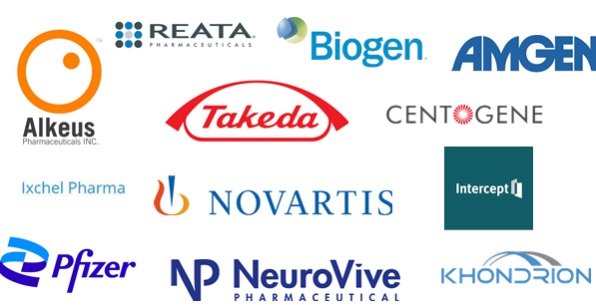
Figure 6: Major key players in the mitochondrial-based therapeutics markets, each contributing through extensive research, innovative therapy development, and strategic initiatives.
The recent increase in activity within the pharmaceutical industry, especially in developing mitochondrial drugs for neurodegenerative diseases, marks a significant shift in focus towards tackling some of the most difficult medical challenges we face today. On February 22, 2024, Abliva announced a substantial financial step by raising approximately USD 4.05 million through the private placement of convertible bonds, a strategic move poised to fund the ongoing development of novel therapeutics. Before that, on December 13, 2023, MitoRx Therapeutics successfully extended its seed financing, laying down a solid foundation for future breakthroughs in this cutting-edge area.
One of the most noteworthy transactions in this sector was the acquisition of Mitokinin by AbbVie for a substantial USD 110 million on October 5, 2023, a testament to the value and potential locked within these innovative companies. The science underpinning this move is epitomized by the development of Mitofusin agonists, announced on May 31, 2023, which target the root causes of neurodegenerative diseases, and the pioneering AAV-AIBP therapy for Alzheimer’s disease unveiled on May 4, 2023. These milestones not only underscore the robust investment and mergers taking place but also highlight the industry’s commitment to combating neurological ailments through mitochondrial therapeutics.
Future Directions for Mitochondrial Function Therapeutics
In the neurodegenerative disease market, the spotlight on mitochondrial dysfunction as a therapeutic target is shining ever brighter. This burgeoning interest is anchored in the substantial role mitochondrial dysfunction plays across a spectrum of neurodegenerative disorders, including Parkinson’s and Alzheimer’s diseases. Yet, the intricate interplay between neurodegenerative diseases and mitochondrial dysfunction demands a nuanced, careful exploration. The complexity inherent in neurodegenerative diseases—shaped by genetics, environmental influences, and the ageing process—presents significant challenges in the straightforward application of therapies targeting mitochondria.
Despite these complexities, pursuing mitochondrial dysfunction as a therapeutic target harbours a wealth of potential. It opens the door to innovative treatment strategies that could profoundly impact the management and outcome of neurodegenerative diseases. The promise held within this area of research is immense, offering a beacon of hope for groundbreaking treatments. However, this promise also calls for a balanced approach that acknowledges the multifaceted nature of neurodegenerative pathologies and the intricacies of mitochondrial biology. This careful consideration is crucial for strategically allocating research efforts and resources, ensuring they are directed toward the most promising and impactful avenues.
Now is the time for action. We call upon the biotech and pharmaceutical sectors to aggressively invest in mitochondrial dysfunction research. This commitment goes beyond financial contributions; it’s an investment in the future of neurodegenerative disease treatment. By prioritizing and funding the exploration of mitochondrial-targeted therapies, we can unlock new horizons in managing and curing these debilitating conditions. Embracing the complexity and channelling resources into this promising research area can lead to transformative treatments that significantly change the course of neurodegenerative diseases. Together, let’s pave the way toward a new era of medical breakthroughs, improving the lives of millions suffering worldwide.
About the author

Follow Sygnature Discovery on LinkedIn to watch Tatiana’s 5 part video series, #MitochondriaUnlocked
Tatiana Rosenstock has had an exceptional career and has made significant contributions to the field of Neuroscience for 20+ years. Her work has focused on topics such as mitochondrial deregulation, transcription deregulation, and autophagy in neurodegenerative diseases, such as Huntington’s Disease, Amyotrophic Lateral Sclerosis, and Schizophrenia.
At Sygnature Discovery, Tatiana is a Principal Scientist overseeing various neuroscience-related projects in different sub-areas such as metabolism (mitochondrial function), biomarkers, microglial function and activation, and neuroplasticity. During this period, she has been working with distinct in-vitro models, named iPSC-derived neurons, primary cortical neurons, Alzheimer`s and Parkinson`s disease fibroblasts, neuroblastomas cell lines, tissue and biofluids from transgenics animal models of Alzheimer`s disease.
